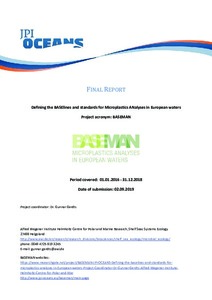Defining the BASElines and standards for Microplastics ANalyses in European waters : Final report Project BASEMAN

View/
Average rating
votes
Date
2019Editor
Gerdts, Gunnar
Status
PublishedPages
25pp.
Metadata
Show full item recordAbstract
Persistent plastic litter amasses. It fragments over time, both before entering and within the marine environment.
Together with micro-sized primary plastic litter from consumer products, this leads to an increasing amount of small
plastic particles, so called microplastics (MP). The ubiquitous presence and massive accumulation of MP in marine
habitats and the uptake of MP by at least 700 marine species biota is now well recognised by scientists and authorities
worldwide. However, the impact of plastic particles on aquatic ecosystems is far from understood. A fundamental issue
precluding assessment of the environmental risks arising from MP is the lack of standard operating procedures (SOP)
for MP sampling and analysis. Consequently, there is a lack of reliable data on concentrations of MP and the composition
of polymers within the marine environment. Comparability of data on MP concentrations is currently hampered by the
huge variety of different methods, each generating data .....
Publisher
JPI-Oceans BASEMAN ProjectDocument Language
enSustainable Development Goals (SDG)
14.1Maturity Level
TRL 8 Actual system completed and "mission qualified" through test and demonstration in an operational environment (ground or space)Best Practice Type
Manual (incl. handbook, guide, cookbook etc)Standard Operating Procedure
Spatial Coverage
EuropeanCitation
Gerdts, G. (ed.) (2019) Defining the BASElines and standards for Microplastics ANalyses in European waters. Project BASEMAN Final report. JPI-Oceans BASEMAN Project, 25pp. DOI: http://dx.doi.org/10.25607/OBP-722Collections
 Repository of community practices in Ocean Research, Applications and Data/Information Management
Repository of community practices in Ocean Research, Applications and Data/Information Management